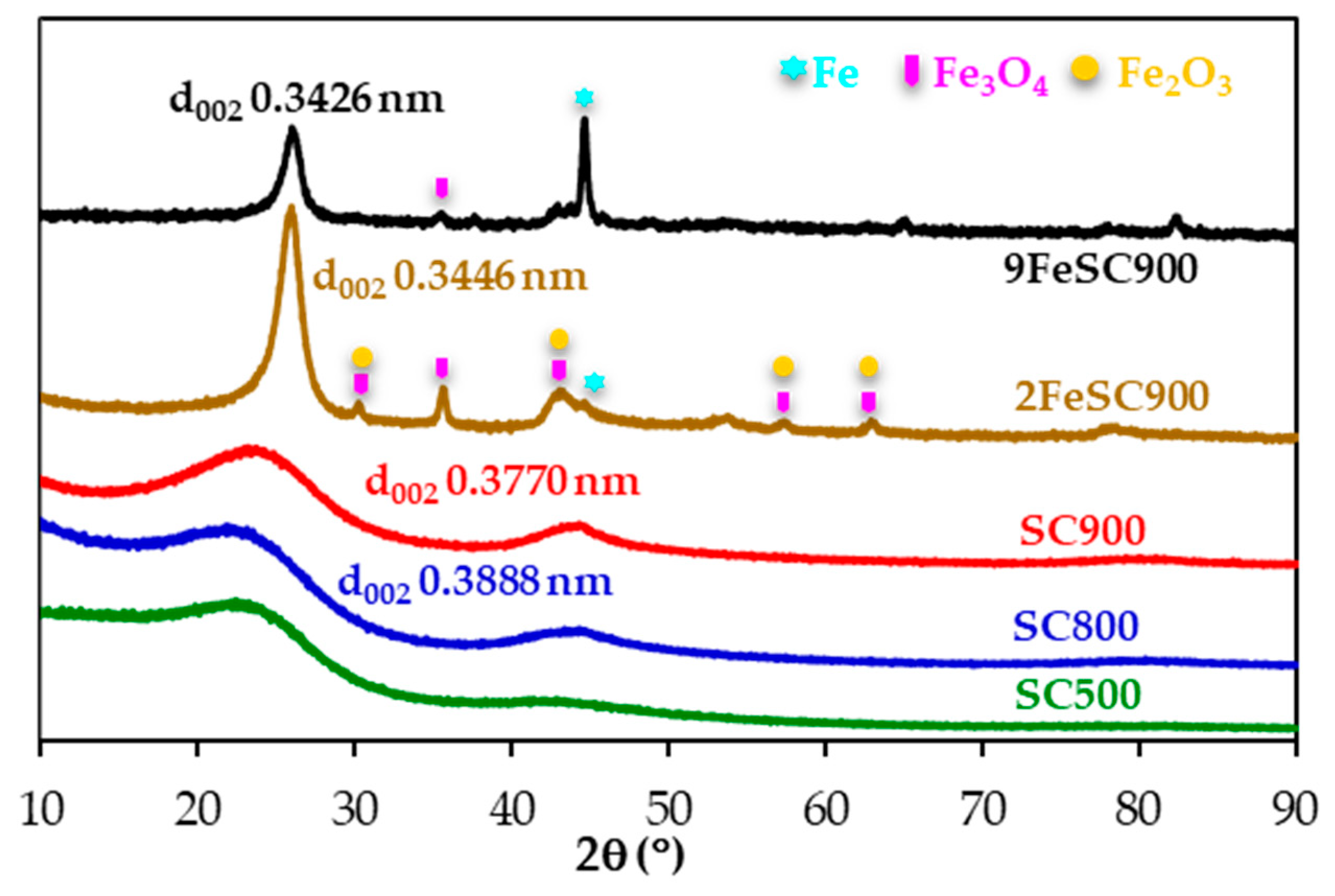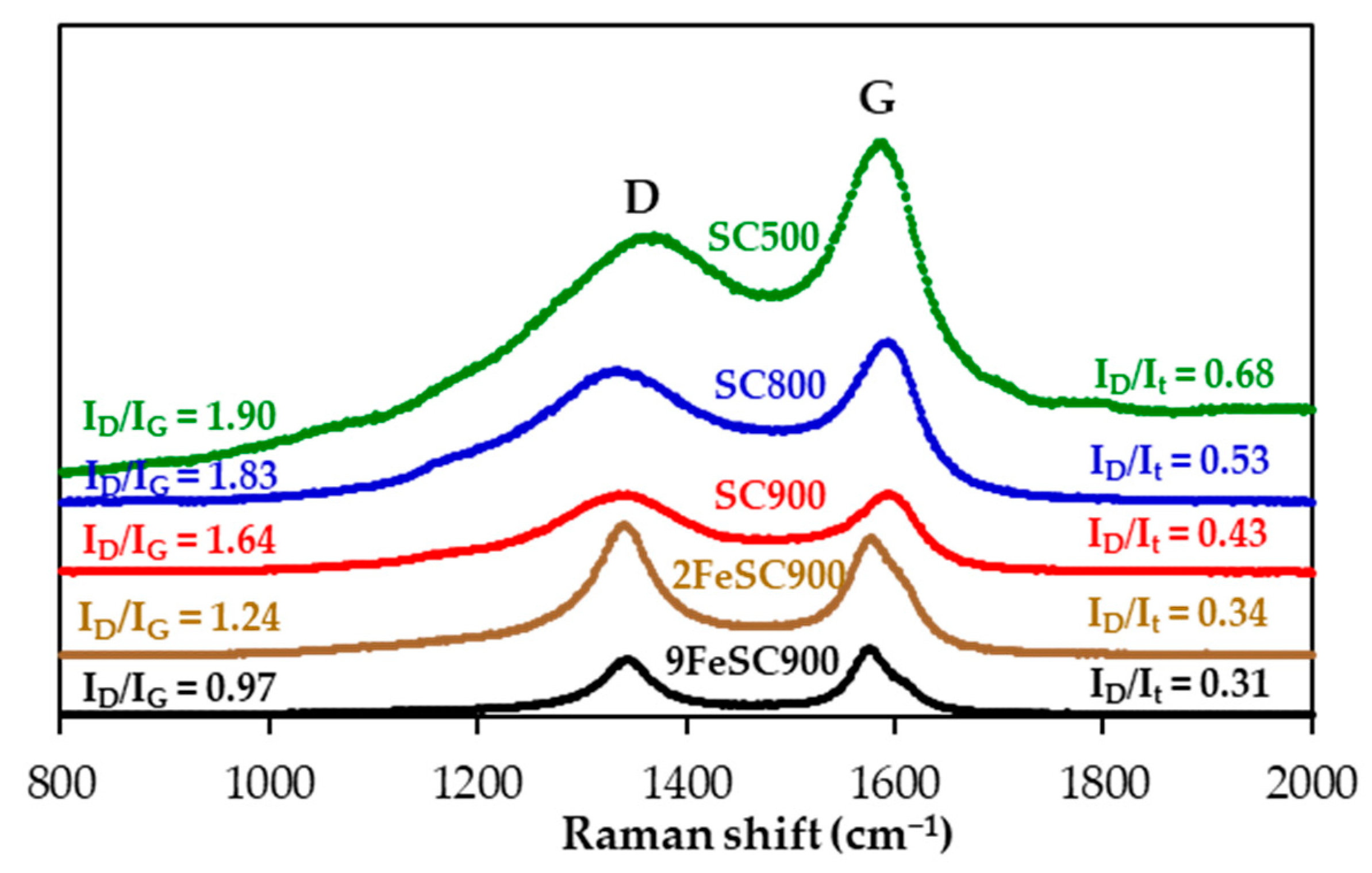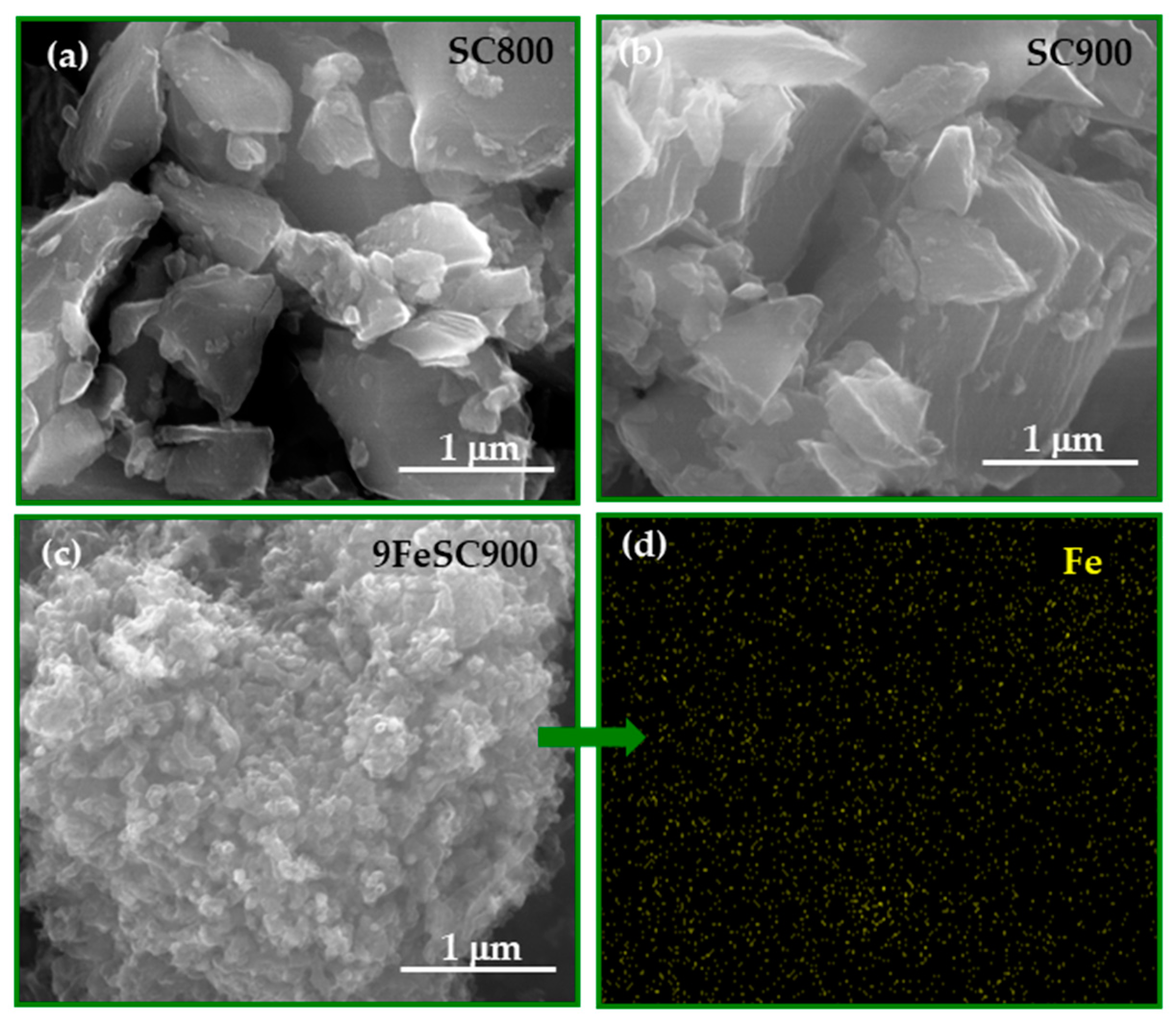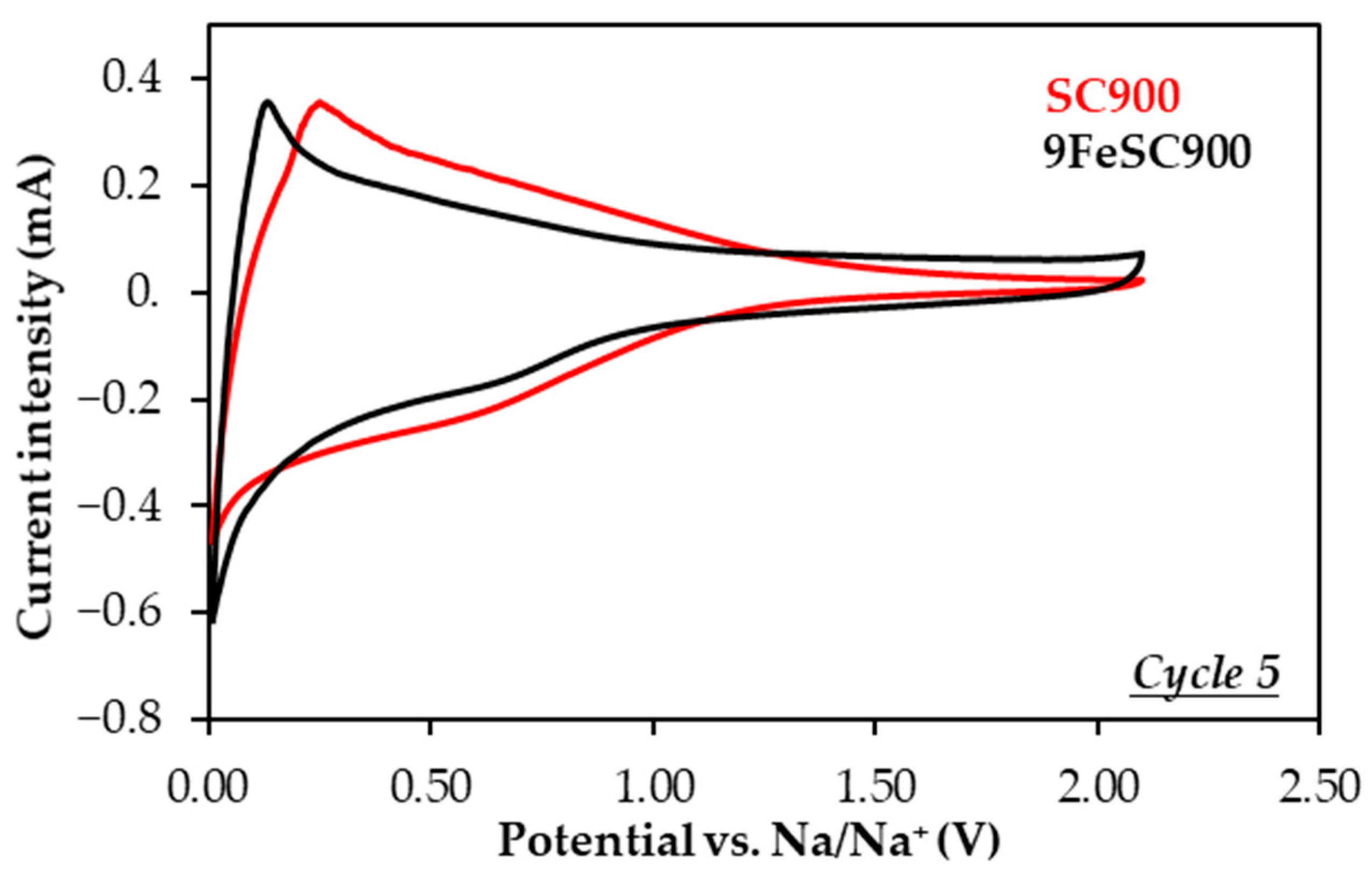Sustainable Carbon Materials from Sucrose as Anodes for Sodium-Ion Batteries
Abstract
1. Introduction
2. Results and Discussion
2.1. Sucrose-Based Carbon Materials: Chemical, Textural, Structural, and Morphological Properties
2.2. Sucrose-Based Carbon Materials: Performance as Anodes in Sodium-Ion Batteries
3. Materials and Methods
3.1. Synthesis of Sucrose-Based Carbons
3.2. Characterization Techniques
3.3. Electrode Preparation, Cell Assembly, and Electrochemical Measurements
4. Conclusions
Supplementary Materials
Author Contributions
Funding
Institutional Review Board Statement
Informed Consent Statement
Data Availability Statement
Acknowledgments
Conflicts of Interest
References
- United Nations. Sustainable Development Goals Report, Special Edition; United Nations: New York, NY, USA, 2023. [Google Scholar]
- Hasa, I.; Mariyappan, S.; Saurel, D.; Adelhem, P.; Koposov, A.Y.; Maaquelier, C.; Croguennec, L.; Casa-Cabanas, M. Challenges of Today for Na-based batteries of the future: From materials to cell metrics. J. Power Sources 2021, 482, 228872. [Google Scholar] [CrossRef]
- Peters, J.F.; Peña Cruz, A.; Weil, M. Exploring the Economic Potential of Sodium-Ion Batteries. Batteries 2019, 5, 10. [Google Scholar] [CrossRef]
- Vaalma, C.; Buchholz, D.; Weil, M.; Passerini, S. A cost and resource analysis of sodium-ion batteries. Nat. Rev. 2018, 3, 18013. [Google Scholar] [CrossRef]
- Gao, Y.; Zhang, H.; Peng, J.; Li, L.; Xiao, Y.; Li, L.; Liu, Y.; Qiao, Y.; Chou, S.-L. A 30-year overview of sodium-ion batteries. Carbon Energy 2024, 6, e464. [Google Scholar] [CrossRef]
- Wang, G.; Yu, M.; Feng, X. Carbon materials for ion-intercalation involved rechargeable battery technologies. Chem. Soc. Rev. 2021, 50, 2388–2443. [Google Scholar] [CrossRef]
- Zhang, T.; Li, C.; Wang, F.; Noori, A.; Mousavi, M.F.; Xia, X.; Zhang, Y. Recent advances in carbon anodes for Sodium-ion batteries. Chem. Rec. 2022, 22, e202200083. [Google Scholar] [CrossRef]
- Sarkar, S.; Roy, S.; Hou, Y.; Sun, S.; Zhang, J.; Zhao, Y. Recent progress in amorphous carbon-based materials for anodes of Sodium-ion batteries: Synthesis strategies, mechanisms, and performance. ChemSusChem 2021, 14, 3693–3723. [Google Scholar] [CrossRef]
- Nobuhara, K.; Nakayama, H.; Nose, M.; Nakanishi, S.; Iba, H. First-principles study of alkali metal-graphite intercalation Compounds. J. Power Sources 2013, 243, 585–587. [Google Scholar] [CrossRef]
- Shao, W.; Shi, H.; Jian, X.; Wu, Z.-S.; Hu, F. Hard-carbon anodes for Sodium-ion batteries: Recent status and challenging perspectives. Adv. Energy Sustain. Res. 2022, 3, 2200009. [Google Scholar] [CrossRef]
- Tan, S.; Yang, H.; Zhang, Z.; Xu, X.; Xu, Y.; Zhou, J.; Zhou, X.; Pan, Z.; Rao, X.; Gu, Y.; et al. The progress of hard carbon as an anode material in Sodium-ion batteries. Molecules 2023, 28, 3134. [Google Scholar] [CrossRef]
- Yang, C.; Zhao, J.; Dong, B.; Lei, M.; Zhang, X.; Xie, W.; Chen, M.; Zhang, K.; Zhou, L. Advances in the structural engineering and commercialization processes of hard carbon for sodium-ion batteries. J. Mater. Chem. A 2024, 12, 1340–1358. [Google Scholar] [CrossRef]
- Thompson, M.; Xia, Q.; Hu, Z.; Zhao, X.S. A review on biomass-derived hard carbon materials for sodium-ion batteries. Mater. Adv. 2021, 2, 5881–5905. [Google Scholar] [CrossRef]
- Huang, S.; Qiu, X.; Wang, C.; Zhong, L.; Zhang, Z.; Yang, S.; Sun, S.; Yang, D.; Zhang, W. Biomass-derived carbon anodes for sodium-ion batteries. New Carbon Mater. 2023, 38, 40–66. [Google Scholar] [CrossRef]
- Jin, Y.; Shi, Z.; Han, T.; Yang, H.; Asfaw, H.D.; Gond, R.; Younesi, R.; Jönsson, P.G.; Yang, W. From waste biomass to hard carbon anodes: Predicting the relationship between biomass processing parameters and performance of hard carbons in Sodium-ion batteries. Processes 2023, 11, 764. [Google Scholar] [CrossRef]
- Lu, B.; Lin, C.; Xiong, H.; Zhang, C.; Fang, L.; Sun, J.; Hu, Z.; Wu, Y.; Fan, X.; Li, G.; et al. Hard-carbon negative electrodes from biomasses for Sodium-ion batterie. Molecules 2023, 28, 4027. [Google Scholar] [CrossRef] [PubMed]
- Stevens, D.A.; Dahn, J.R. High capacity anode materials for rechargeable sodium-ion batteries. J. Electrochem. Soc. 2000, 147, 1271. [Google Scholar] [CrossRef]
- Raspado, L.; Speyer, L.; Dolmont, M.; Cahen, S.; Fontana, S.; Herold, C. Tuning the porosity of hard carbons elaborated from sucrose. J. Phys. Chem. Solids 2024, 191, 11013. [Google Scholar] [CrossRef]
- Kubota, K.; Shimadzu, S.; Yabuuchi, N.; Tominaka, S.; Shiraishi, S.; Abreu-Sepúlveda, M.; Manivanna, A.; Gotoh, K.; Fukunishi, M.; Dahbi, M.; et al. Structural Analysis of Sucrose-Derived Hard Carbon and Correlation with the Electrochemical Properties for Lithium, Sodium, and Potassium Insertion. Chem. Mater. 2020, 32, 2961–2977. [Google Scholar] [CrossRef]
- Bommier, C.; Luo, W.; Gao, W.-Y.; Greaney, A.; Ma, S.; Ji, X. Predicting capacity of hard carbon anodes in sodium-ion batteries using porosity measurements. Carbon 2014, 76, 165–174. [Google Scholar] [CrossRef]
- Pan, Y.; Ji, B.; Wang, L.; Sun, Y.; Li, L.; Wu, X.; Zhou, P. Manipulating micropore structure of hard carbon as high-performance anode for Sodium-Ion Batteries. Electrochim. Acta 2024, 506, 145042. [Google Scholar] [CrossRef]
- Nagmani; Kumar, A.; Puravanka, S. Optimizing ultramicroporous hard carbon spheres in carbonate ester-based electrolytes for enhanced sodium storage in half-/full-cell sodium-ion batteries. Battery Energy 2022, 1, 202220007. [Google Scholar] [CrossRef]
- Nagmani; Manna, S.; Puravankara, S. Hierarchically porous closed-pore hard carbon as a plateau-dominated high-performance anode for sodium-ion batteries. Chem. Commun. 2024, 60, 3071–3074. [Google Scholar] [CrossRef] [PubMed]
- Zhang, H.; Ming, H.; Zhang, W.; Cao, G.; Yang, Y. Coupled Carbonization Strategy toward advanced hard carbon for high-energy sodium-ion battery. ACS Appl. Mater. Interfaces 2017, 9, 23766–23774. [Google Scholar] [CrossRef] [PubMed]
- Luo, W.; Bommier, C.; Jian, Z.; Li, X.; Carter, R.; Vail, S.; Lu, Y.; Lee, J.-J.; Ji, X. Low-surface-area hard carbon anode for Na-ion batteries via graphene oxide as a dehydration agent. ACS Appl. Mater. Interfaces 2015, 7, 2626–2631. [Google Scholar] [CrossRef]
- Thommes, M.; Kaneko, K.; Neimark, A.V.; Olivier, J.P.; Rodriguez-Reinoso, F.; Rouquerol, J.; Sing, K.S.W. Physisorption of gases, with special reference to the evaluation of surface area and pore size distribution (IUPAC Technical Report). Pure Appl. Chem. 2015, 87, 1051–1069. [Google Scholar] [CrossRef]
- García, R.; Rodríguez, E.; Díez, M.A.; Arenillas, A.; Villanueva, S.F.; Rey-Raap, N.; Cuesta, C.; López-Antón, M.A.; Martínez-Tarazona, M.R. Synthesis of Micro- and Mesoporous Carbon Foams with Nanodispersed Metals for Adsorption and Catalysis Applications. Materials 2023, 16, 1336. [Google Scholar] [CrossRef]
- Hayward, S.C.; Smales, J.; Pauw, B.R.; Takeguchi, M.; Kulak, A.; Hunter, R.D.; Schnepp, Z. The effect of catalyst precursors on the mechanism of iron-catalysed graphitization of cellulose. RSC Sustain. 2024, 2, 3490–3499. [Google Scholar] [CrossRef]
- Franklin, R.E. The structure of graphitic carbons. Acta Crystallogr. 1951, 4, 253–261. [Google Scholar] [CrossRef]
- Cao, Y.; Xiao, L.; Sushko, M.L.; Wang, W.; Schwenzer, B.; Xiao, J.; Nie, Z.; Saraf, L.V.; Yang, Z.; Liu, J. Sodium ion insertion in hollow carbon nanowires for battery applications. Nano Lett. 2012, 12, 3783–3787. [Google Scholar] [CrossRef]
- Yin, L.; Pan, Y.; Li, M.; Zhao, Y.; Luo, S. Facile and scalable synthesis of α-Fe2O3/γ-Fe2O3/Fe/C nanocomposite as advanced anode materials for lithium/sodium ion batteries. Nanotechnology 2020, 31, 155402. [Google Scholar] [CrossRef]
- Meng, J.; Jia, G.; Yang, H.; Wang, M. Recent advances for SEI of hard carbon anode in sodium-ion batteries: A mini review. Front. Chem. 2022, 10, 986541. [Google Scholar] [CrossRef] [PubMed]
- Xiao, B.; Rojo, T.; Li, X. Hard carbon as Sodium-ion battery anodes: Progress and challenges. ChemSusChem 2019, 12, 133–144. [Google Scholar] [CrossRef]
- Bommier, C.; Surta, T.W.; Dolgos, M.; Ji, X. New mechanistic insights on Na-ion storage in nongraphitizable carbon. Nano Lett. 2015, 15, 5888–5892. [Google Scholar] [CrossRef] [PubMed]
- Zhang, B.; Ghimbeu, C.M.; Laberty, C.; Vix-Guterl, C.; Tarascon, J.M. Correlation between microstructure and Na storage behavior in hard carbon. Adv. Energy Mater. 2016, 6, 1501588. [Google Scholar] [CrossRef]
- Jin, Y.; Sun, S.; Ou, M.; Liu, Y.; Fan, C.; Sun, X.; Peng, J.; Li, Y.; Qiu, Y.; Wei, P.; et al. High-performance hard carbon anode: Tunable local structures and Sodium storage mechanism. ACS Appl. Energy Mater. 2018, 1, 2295–2305. [Google Scholar] [CrossRef]
- Chen, X.; Liu, C.; Fang, Y.; Ai, X.; Zhong, F.; Yang, H.; Cao, Y. Understanding of the sodium storage mechanism in hard carbon anodes. Carbon Energy 2022, 4, 1133–1150. [Google Scholar] [CrossRef]
- Sun, N.; Qiu, J.; Xu, B. Understanding of Sodium storage mechanism in hard carbons: Ongoing development under debate. Adv. Energy Mater. 2022, 12, 2200715. [Google Scholar] [CrossRef]
- Stevens, D.A.; Dahn, J.R. An In Situ Small-Angle X-Ray Scattering Study of Sodium Insertion into a Nanoporous Carbon Anode Material within an Operating Electrochemical Cell. J. Electrochem. Soc. 2000, 147, 4428. [Google Scholar] [CrossRef]
- Lu, J.-L.; Zhang, X.; Miao, Y.-X.; Wen, M.-X.; Yan, W.-J.; Lu, P.; Wang, Z.-R.; Sun, Q. In-situ plantation of Fe3O4@C nanoparticles on reduced graphene oxide nanosheet as high-performance anode for lithium/sodium-ion batteries. Appl. Surf. Sci. 2021, 546, 149163. [Google Scholar]
- Cuesta, C.; Rodríguez, E.; Villanueva, S.F.; Diez, M.A.; Arenillas, A.; López-Antón, M.A.; Martínez-Tarazona, M.R.; García, R. Sustainable straightforward synthesis of hierarchically porous graphitised carbon foams with nanodispersed magnetite and elemental iron particles. Ind. Crops Prod. 2024, 222, 120058. [Google Scholar] [CrossRef]
- Sing, K.S.W. Reporting physisorption data for gas/solid systems with special reference to the determination of surface area and porosity (Recommendations 1984). Pure Appl. Chem. 1985, 57, 603–619. [Google Scholar] [CrossRef]
- Dubinin, M.M. Fundamentals of the theory of adsorption in micropores of carbon adsorbents: Characteristics of their adsorption properties and microporous structures. Carbon 1989, 27, 457–467. [Google Scholar] [CrossRef]
- Lecloux, A.; Pirard, J.P. The importance of standard isotherms in the analysis of adsorption isotherms for determining the porous texture of solids. J. Colloid Interface Sci. 1979, 70, 265–281. [Google Scholar] [CrossRef]
- Rodríguez-García, J.; Cameán, I.; Ramos, A.; Rodríguez, E.; García, A.B. Graphitic carbon foams as anodes for sodium-ion batteries in glyme-based electrolytes. Electrochim. Acta 2018, 270, 236–244. [Google Scholar] [CrossRef]





| Material | C (wt.%) | H (wt.%) | N (wt.%) | S (wt.%) | O (wt.%) | Fe (wt.%) |
|---|---|---|---|---|---|---|
| SC500 | 84.20 | 3.14 | 0.27 | 0.01 | 12.29 | -- |
| SC800 | 94.96 | 0.87 | 0.45 | 0.01 | 1.97 | -- |
| SC900 | 95.90 | 0.96 | 0.82 | 0.01 | 2.76 | -- |
| 2FeSC900 | 95.18 | 0.64 | 0.45 | 0.01 | 2.13 | 2.20 |
| 9FeSC900 | 89.92 | 0.28 | 0.31 | 0.01 | 1.07 | 8.80 |
| Material | SBET (m2 g−1) | Vmeso (cm3 g−1) | Vmicro (cm3 g−1) | Dp (nm) | Sext (m2 g−1) |
|---|---|---|---|---|---|
| SC500 | -- | -- | -- | -- | -- |
| SC800 | -- | -- | -- | -- | -- |
| SC900 | -- | -- | -- | -- | -- |
| 2FeSC900 | 163 | 0.097 | 0.059 | 5 | 114 |
| 9FeSC900 | 195 | 0.169 | 0.079 | 5 | 164 |
| Electrode | Cdisc 1st Cycle | Cdisc 2nd Cycle | Cdisc 25th Cycle | Cdisc 100th Cycle | CDISC 200th Cycle | CDISC 400th Cycle | Cirr 1 1st Cycle | R 2 25–400th Cycles |
|---|---|---|---|---|---|---|---|---|
| SC500 | 118 | 45 | 81 | 88 | 84 | 80 | 78 | 93 |
| SC800 | 270 | 112 | 104 | 105 | 102 | 96 | 64 | 94 |
| SC900 | 145 | 173 | 107 | 92 | 110 | 111 | 77 | 99 |
| 2FeSC900 | 191 | 55 | 47 | 43 | 42 | 40 | 80 | 91 |
| 9FeSC900 | 284 | 68 | 48 | 43 | 42 | 39 | 80 | 90 |
Disclaimer/Publisher’s Note: The statements, opinions and data contained in all publications are solely those of the individual author(s) and contributor(s) and not of MDPI and/or the editor(s). MDPI and/or the editor(s) disclaim responsibility for any injury to people or property resulting from any ideas, methods, instructions or products referred to in the content. |
© 2025 by the authors. Licensee MDPI, Basel, Switzerland. This article is an open access article distributed under the terms and conditions of the Creative Commons Attribution (CC BY) license (https://creativecommons.org/licenses/by/4.0/).
Share and Cite
Lobato, B.; Cuesta, N.; Cameán, I.; Martínez-Tarazona, M.R.; García, R.; Arenillas, A.; García, A.B. Sustainable Carbon Materials from Sucrose as Anodes for Sodium-Ion Batteries. Molecules 2025, 30, 1003. https://doi.org/10.3390/molecules30051003
Lobato B, Cuesta N, Cameán I, Martínez-Tarazona MR, García R, Arenillas A, García AB. Sustainable Carbon Materials from Sucrose as Anodes for Sodium-Ion Batteries. Molecules. 2025; 30(5):1003. https://doi.org/10.3390/molecules30051003
Chicago/Turabian StyleLobato, Belén, Nuria Cuesta, Ignacio Cameán, Maria Rosa Martínez-Tarazona, Roberto García, Ana Arenillas, and Ana B. García. 2025. "Sustainable Carbon Materials from Sucrose as Anodes for Sodium-Ion Batteries" Molecules 30, no. 5: 1003. https://doi.org/10.3390/molecules30051003
APA StyleLobato, B., Cuesta, N., Cameán, I., Martínez-Tarazona, M. R., García, R., Arenillas, A., & García, A. B. (2025). Sustainable Carbon Materials from Sucrose as Anodes for Sodium-Ion Batteries. Molecules, 30(5), 1003. https://doi.org/10.3390/molecules30051003










